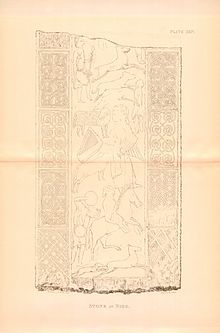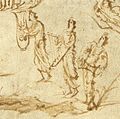
The harp is a stringed musical instrument that has individual strings running at an angle to its soundboard; the strings are plucked with the fingers. Harps can be made and played in various ways, standing or sitting, and in orchestras or concerts. Its most common form is triangular in shape and made of wood. Some have multiple rows of strings and pedal attachments.
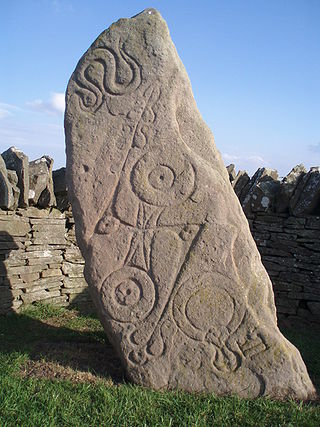
The Picts were a group of peoples in what is now Scotland north of the Firth of Forth, in the Early Middle Ages. Where they lived and details of their culture can be gleaned from early medieval texts and Pictish stones. The name Picti appears in written records as an exonym from the late third century AD. They are assumed to have been descendants of the Caledonii and other northern Iron Age tribes. Their territory is referred to as "Pictland" by modern historians. Initially made up of several chiefdoms, it came to be dominated by the Pictish kingdom of Fortriu from the seventh century. During this Verturian hegemony, Picti was adopted as an endonym. This lasted around 160 years until the Pictish kingdom merged with that of Dál Riata to form the Kingdom of Alba, ruled by the House of Alpin. The concept of "Pictish kingship" continued for a few decades until it was abandoned during the reign of Caustantín mac Áeda.

The lyre is a stringed musical instrument that is classified by Hornbostel–Sachs as a member of the lute family of instruments. In organology, a lyre is considered a yoke lute, since it is a lute in which the strings are attached to a yoke that lies in the same plane as the sound table, and consists of two arms and a crossbar.
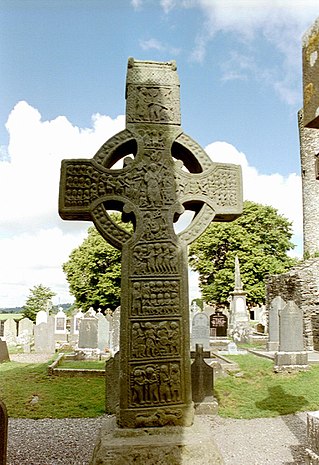
A high cross or standing cross is a free-standing Christian cross made of stone and often richly decorated. There was a unique Early Medieval tradition in Ireland and Britain of raising large sculpted stone crosses, usually outdoors. These probably developed from earlier traditions using wood, perhaps with metalwork attachments, and earlier pagan Celtic memorial stones; the Pictish stones of Scotland may also have influenced the form. The earliest surviving examples seem to come from the territory of the Anglo-Saxon kingdom of Northumbria, which had been converted to Christianity by Irish missionaries; it remains unclear whether the form first developed in Ireland or Britain.

A psaltery is a fretboard-less box zither and is considered the archetype of the zither and dulcimer. Plucked keyboard instruments such as the harpsichord were also inspired by it. Its resonance box is usually trapezoidal, rectangular or in the form of a "pig's head" and often richly decorated.

Scotland is internationally known for its traditional music, which remained vibrant throughout the 20th century and into the 21st when many traditional forms worldwide lost popularity to pop music. Despite emigration and a well-developed connection to music imported from the rest of Europe and the United States, the music of Scotland has kept many of its traditional aspects and influenced many other forms of music.
Pibroch, piobaireachd or ceòl mòr is an art music genre associated primarily with the Scottish Highlands that is characterised by extended compositions with a melodic theme and elaborate formal variations. Strictly meaning 'piping' in Scottish Gaelic, piobaireachd has for some four centuries been music of the great Highland bagpipe.
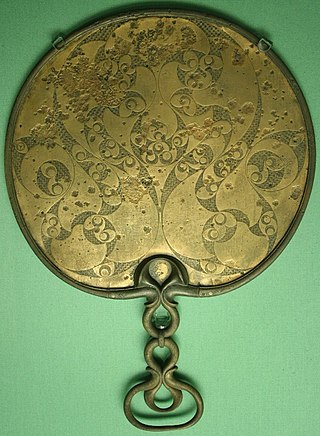
Celtic art is associated with the peoples known as Celts; those who spoke the Celtic languages in Europe from pre-history through to the modern period, as well as the art of ancient peoples whose language is uncertain, but have cultural and stylistic similarities with speakers of Celtic languages.
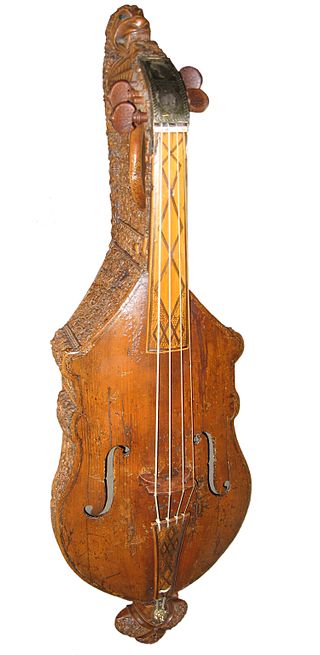
The citole was a string musical instrument, closely associated with the medieval fiddles and commonly used from 1200–1350. It was known by other names in various languages: cedra, cetera, cetola, cetula, cistola, citola, citula, citera, chytara, cistole, cithar, cuitole, cythera, cythol, cytiole, cytolys, gytolle, sitole, sytholle, sytole, and zitol. Like the modern guitar, it was manipulated at the neck to get different notes, and picked or strummed with a plectrum. Although it was largely out of use by the late 14th century, the Italians "re-introduced it in modified form" in the 16th century as the cetra, and it may have influenced the development of the guitar as well. It was also a pioneering instrument in England, introducing the populace to necked, plucked instruments, giving people the concepts needed to quickly switch to the newly arriving lutes and gitterns. Two possible descendant instruments are the Portuguese guitar and the Corsican Cetera, both types of cittern.

The Celtic harp is a triangular frame harp traditional to the Celtic nations of northwest Europe. It is known as cláirseach in Irish, clàrsach in Scottish Gaelic, telenn in Breton and telyn in Welsh. In Ireland and Scotland, it was a wire-strung instrument requiring great skill and long practice to play, and was associated with the Gaelic ruling class. It appears on Irish coins, Guinness products, and the coat of arms of the Republic of Ireland, Montserrat, Canada and the United Kingdom.

The Nigg Stone is an incomplete Class II Pictish cross-slab, perhaps dating to the end of the 8th century.
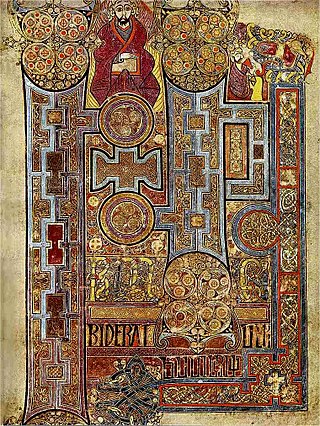
Insular art, also known as Hiberno-Saxon art, was produced in the post-Roman era of Great Britain and Ireland. The term derives from insula, the Latin term for "island"; in this period Britain and Ireland shared a largely common style different from that of the rest of Europe. Art historians usually group Insular art as part of the Migration Period art movement as well as Early Medieval Western art, and it is the combination of these two traditions that gives the style its special character.

The cythara is a wide group of stringed instruments of medieval and Renaissance Europe, including not only the lyre and harp but also necked, string instruments. In fact, unless a medieval document gives an indication that it meant a necked instrument, then it likely was referring to a lyre. It was also spelled cithara or kithara and was Latin for the Greek lyre. However, lacking names for some stringed instruments from the medieval period, these have been referred to as fiddles and citharas/cytharas, both by medieval people and by modern researchers. The instruments are important as being ancestors to or influential in the development of a wide variety of European instruments, including fiddles, vielles, violas, citoles and guitars. Although not proven to be completely separate from the line of lute-family instruments that dominated Europe, arguments have been made that they represent a European-based tradition of instrument building, which was for a time separate from the lute-family instruments.

The Lamont Harp, or Clàrsach Lumanach is a Scottish Clarsach currently displayed in the National Museum of Scotland. It is believed to date back to the 15th century, and to have originated in Argyll. Along with the Queen Mary Harp and the Trinity College harp, it is one of the only three surviving medieval Gaelic harps.
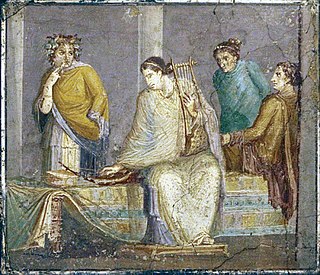
The kithara, or Latinized cithara, was an ancient Greek musical instrument in the yoke lutes family. It was a seven-stringed professional version of the lyre, which was regarded as a rustic, or folk instrument, appropriate for teaching music to beginners. As opposed to the simpler lyre, the cithara was primarily used by professional musicians, called kitharodes. In modern Greek, the word kithara has come to mean "guitar", a word which etymologically stems from kithara.

St Orland's Stone is a Class II Pictish Cross-Slab at Cossans, near Kirriemuir and Forfar, Angus, Scotland

In the early Middle Ages, there were distinct material cultures evident in the different federations and kingdoms within what is now Scotland. Pictish art was the only uniquely Scottish medieval style; it can be seen in the extensive survival of carved stones, particularly in the north and east of the country, which hold a variety of recurring images and patterns. It can also be seen in elaborate metal work that largely survives in buried hoards. Irish-Scots art from the kingdom of Dál Riata suggests that it was one of the places, as a crossroads between cultures, where the Insular style developed.
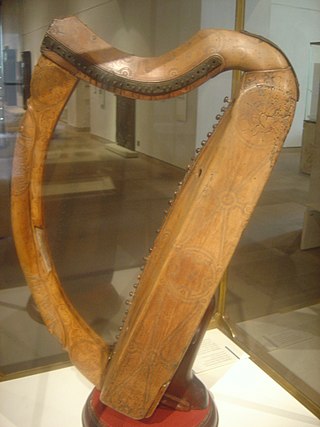
Music in Medieval Scotland includes all forms of musical production in what is now Scotland between the fifth century and the adoption of the Renaissance in the early sixteenth century. The sources for Scottish Medieval music are extremely limited. There are no major musical manuscripts for Scotland from before the twelfth century. There are occasional indications that there was a flourishing musical culture. Instruments included the cithara, tympanum, and chorus. Visual representations and written sources demonstrate the existence of harps in the Early Middle Ages and bagpipes and pipe organs in the Late Middle Ages. As in Ireland, there were probably filidh in Scotland, who acted as poets, musicians and historians. After this "de-gallicisation" of the Scottish court in the twelfth century, a less highly regarded order of bards took over the functions of the filidh and they would continue to act in a similar role in the Scottish Highlands and Islands into the eighteenth century.

The Anglo-Saxon lyre, also known as the Germanic lyre, a Rotta, or the Viking lyre, is a large plucked and strummed lyre that was played in Anglo-Saxon England, and more widely, in Germanic regions of northwestern Europe. The oldest lyre found in England dates before 450 AD and the most recent dates to the 10th century. The Anglo-Saxon lyre is depicted in several illustrations and mentioned in Anglo-Saxon literature and poetry. Despite this, knowledge of the instrument was largely forgotten until the 19th century when two lyres were found in cemetery excavations in southwest Germany. The archaeological excavation at Sutton Hoo in 1939, and the correct reconstruction of the lyre in 1970, brought about the realisation that the lyre was "the typical early Germanic stringed instrument."

The medieval harp refers to various types of harps played throughout Europe during the Middle Ages. The defining features are a three-sided frame and strings made of wire or gut. The instrument was most popular in Ireland, Scotland, England, Wales, and Scandinavia. Most information about the medieval harp comes from art and poetry of the era, though some original instruments survive and are available to view in museums. Performers play modern reconstructions of medieval harps today. The instrument is the predecessor to the concert grand pedal harp.
